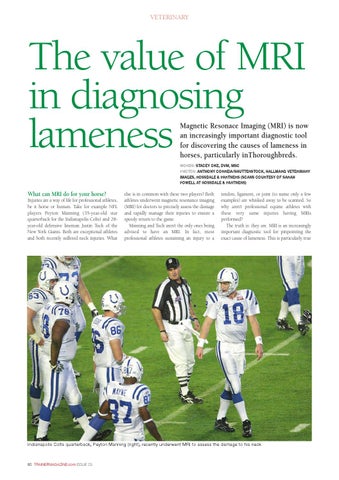MRI ISSUE 23_Jerkins feature.qxd 31/01/2012 15:34 Page 1
VETERINARY
The value of MRI in diagnosing lameness
Magnetic Resonace Imaging (MRI) is now an increasingly important diagnostic tool for discovering the causes of lameness in horses, particularly inThoroughbreds. WORDS: Stacey Oke, DVM, MSc PHOtOS: aNtHONy cORReIa/SHUtteRStOck, HaLLMaRQ VeteRINaRy IMaGeS, ROSSDaLe & PaRtNeRS (ScaNS cOURteSy Of SaRaH POWeLL at ROSSDaLe & PaRtNeRS)
What can MRI do for your horse? Injuries are a way of life for professional athletes, be it horse or human. Take for example NFL players Peyton Manning (35-year-old star quarterback for the Indianapolis Colts) and 28year-old defensive lineman Justin Tuck of the New York Giants. Both are exceptional athletes and both recently suffered neck injuries. What
else is in common with these two players? Both athletes underwent magnetic resonance imaging (MRI) for doctors to precisely assess the damage and rapidly manage their injuries to ensure a speedy return to the game. Manning and Tuck aren’t the only ones being advised to have an MRI. In fact, most professional athletes sustaining an injury to a
tendon, ligament, or joint (to name only a few examples) are whisked away to be scanned. So why aren’t professional equine athletes with these very same injuries having MRIs performed? The truth is: they are. MRI is an increasingly important diagnostic tool for pinpointing the exact cause of lameness. This is particularly true
Indianapolis Colts quarterback, Peyton Manning (right), recently underwent MRI to assess the damage to his neck
50 TRAINERMAGAZINE.com ISSUE 23
